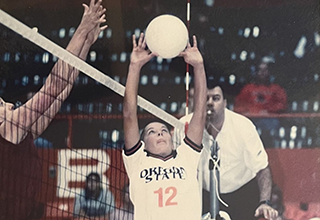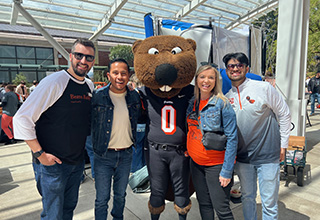Trent Bray and a team in transition.
By Kerry Eggers, ’75
It’s a frigid, late November Friday night as Oregon State defensive coordinator Trent Bray, ’08, makes the 45-minute drive from Eugene to Corvallis with a couple of friends, including tight ends coach Brian Wozniak.The glow of what had been a hallmark season for the Beavers — with, at one point, an 8-2 record and No. 10 national ranking — has dimmed after a 31-7 loss to arch rival Oregon.
What’s more, only days earlier head coach Jonathan Smith, ’02, had confided in his staff that he was leaving for Michigan State after the game against the Ducks. The demise of the Pac-12 — and Oregon State’s position in limbo — was his primary reason. Smith invites most of his staff, including Bray and Wozniak, to join him. Sunday morning, when a chartered plane takes Smith to East Lansing, Wozniak is one of six coaches who go with him. Bray is not.
Meanwhile, a grassroots drive to push Bray as Smith’s successor is underway. Contributions in various iterations of $44 — Bray’s OSU uniform number as a player — pour into the coffers of Beaver Nation.
In the space of 72 hours, more than 1,000 commitments worth about $360,000 arrive, putting the NIL collective over its goal for the “Mission to $1 Million” challenge campaign. Three days later, the university announces Bray is the Beavers’ new head coach.
Why Bray? For one thing, continuity. He is not a Beaver born, but he is certainly a Beaver bred.
Bray’s father, Craig, was the defensive coordinator at Oregon State in the early 2000s after a stint at Washington State University. Bray spent high school in Pullman but played at OSU from 2002-05, a smash-mouth linebacker who earned All-Pac-10 honors as a senior. After his playing days ended, he served nine years as a grad assistant, full-time assistant and finally D-coordinator at his alma mater.

Bray, wearing No. 44, squares off against
Stanford.
He played for the Beavers from
2002 to 2005. (Photo credit: OSU Athletics)
“I love this place and want it to be as good as it can be,” he says. “I’m very motivated by that.”
Bray, 41, is single, with no children. Those close to him say he is wed to the game.
“Trent’s kids are the players he works with every year, mentoring them, guiding them, helping raise them to be responsible adults,” says friend Scott Sanders, ’90, a longtime coach in his own right at Corvallis’ Crescent Valley High.
Mark Banker, Bray’s defensive coordinator during his playing days at Oregon State, is his next-door neighbor. “I see him go out in the morning; I don’t see him coming back at night,” Banker says. “For Trent, football has been life, and life has been football.”
Bray could have been on that plane bound for Michigan State but chose to stay home. His former players both appreciate that and believe in him as a coach.
“He was great, especially after he got promoted to D-coordinator,” says Jack “Jackhammer” Colletto, ’23, a member of the Pittsburgh Steelers’ practice squad in 2023. “I was all for the change. On the defensive side of the ball, the Beavers are going to be just as good with him as head coach — and if they continue to get talent and build on it, maybe better.”
During Bray’s first six weeks on the job, he was consumed by two priorities: assembling a coaching staff and recruiting. He brought back former Beavers as his coordinators — Ryan Gunderson, ’07, on offense and Keith Heyward, ’03, on defense — as well as Kyle Devan, ’08, as offensive line coach.
Was it important to have some coaches on his staff who had played and coached at Oregon State?
“Yes, in the sense that I want people who want to be here. I want guys who are not just looking for a paycheck, but also want to raise their family here in Corvallis,” Bray says. “They are young, energetic and talented, and they have done a great job recruiting.”
College football recruiting has changed since the advent of the transfer portal, which began in 2018 but took on a bigger role in 2021. There are now two “windows” when student-athletes can transfer from one school to another, the first running from Dec. 4 to Jan. 2. Once players’ names are in the portal, they are free to move between programs without penalty.
That means the recruiting process encompasses not only landing high school and junior college talent, but also keeping other schools from raiding your players — while doing your best to take the best of theirs.
OSU saw heavy losses after Smith left, including quarterback Aidan Chiles, tight end Jack Velling and offensive guard Tanner Miller, who all went to Michigan State. The Beavers, however, reaped incoming talent for the 2024 season, as well.
“We had holes we had to address,”Bray says. “We have added talent that will help us improve in many areas of need.”
During his first press conference in late November, Bray spoke optimistically about the Beavers’ potential in 2024. “I truly believe we are more than capable of getting to the college football playoffs next year,” he said. Six weeks later, the coach wasn’t backing away from the statement.
“With the coaching staff we have in place, with the talent we have and the way our schedule is set up, we have a chance to win a lot of games,” Bray says.
Pollyanna isn’t coaching the Beavers. Bray is a rookie head coach, but he knows nothing will come easily.
“Through all this adversity, Trent is doing what he does best — being a leader,” says Sanders. “The parents and families of recruits are learning about the new coach at Oregon State. That is a big reason why they are choosing to come here.”
OSU linebacker Richard Seigler, ’05, speaks for many: “We needed somebody with the loyalty factor, with all the things that have gone on … to be able to trust somebody with a deep connection to the university and the community,” he says. “He might be tasked with one of the greatest challenges at Oregon State, at least in recent memory, as we are trying to transition and find our way.”





